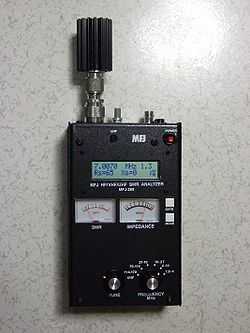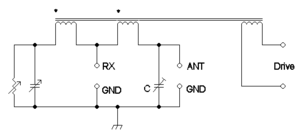Antenna analyzer

An antenna analyzer (also known as a noise bridge, RX bridge, SWR analyzer, or RF analyzer) is a device used for measuring the efficiency of antenna systems in radio electronics applications.
Theory of operation
The antenna analyzer is essentially a bridge circuit where two legs are frequency-dependent complex-valued impedances. One leg is a circuit in the analyzer with calibrated components whose combined impedance can be read on a scale. The other leg is the unknown – either an antenna or a reactive component.
To measure impedance, the Bridge is adjusted, so that the two legs have the same impedance. When the two impedances are the same, the bridge is balanced. Using this circuit it is possible to either measure the impedance of the antenna connected between ANT and GND, or it is possible to adjust an antenna, until it has the same impedance as the network on the left side of the diagram below. The bridge can be driven either with white noise or a simple carrier (connected to drive). In the case of white noise the amplitude of the exciting signal can be very low and a radio receiver used as the detector. In the case where a simple carrier is used then depending on the level either a diode detector or a receiver can be used. In both cases a null will indicate when the bridge is balanced.
Unlike an SWR meter which measures the standing wave ratio in the cable feeding the antenna, a complex-impedance antenna analyzer requires little or no transmitted power applied to the antenna. The SWR meter works by measuring the reflected wave from the antenna back to the transmitter, which is minimal when the antenna is balanced. A badly tuned antenna can produce enough reflected power to damage the transmitter. Since an RX bridge can be used without transmitting, there is no risk of transmitter damage.[1][2]
Uses
In amateur radio, an antenna analyzer is a common tool used for troubleshooting antennas and feedlines as well as fine tuning their performance.[3]
References
- ↑ Practical Radio Frequency Test and Measurement: A Technician's Handbook by Joseph J. Carr, P. 319. Published by Newnes, 1999. ISBN 0-7506-7161-0, ISBN 978-0-7506-7161-3
- ↑ Secrets of RF Circuit Design by Joseph J. Carr, Chapter 17, Building and using the RF noise bridge. ISBN 0-07-137067-6
- ↑ The ARRL Handbook for Radio Communications 2007: The Comprehensive RF Engineering Reference by Mark J. Wilson, Dana G. Reed. Published by American Radio Relay League, ISBN 0-87259-976-0, ISBN 978-0-87259-976-5
See also
| Wikimedia Commons has media related to Antenna analyzer. |
